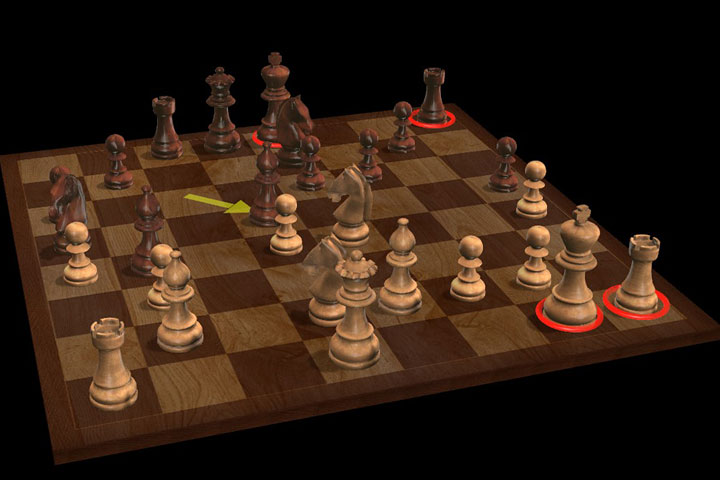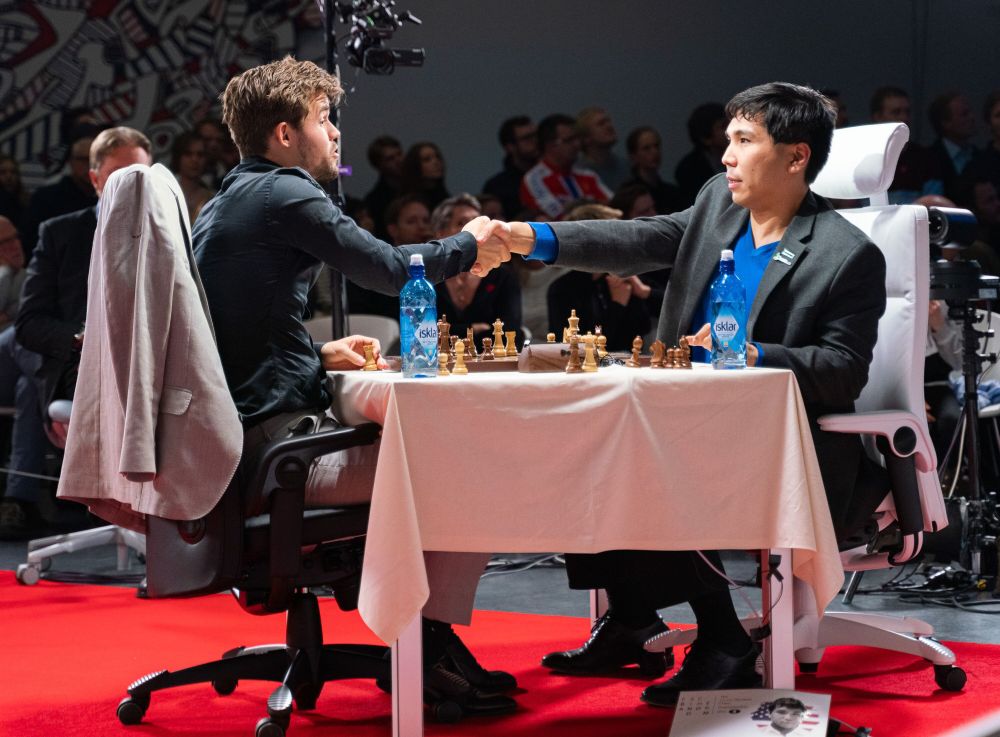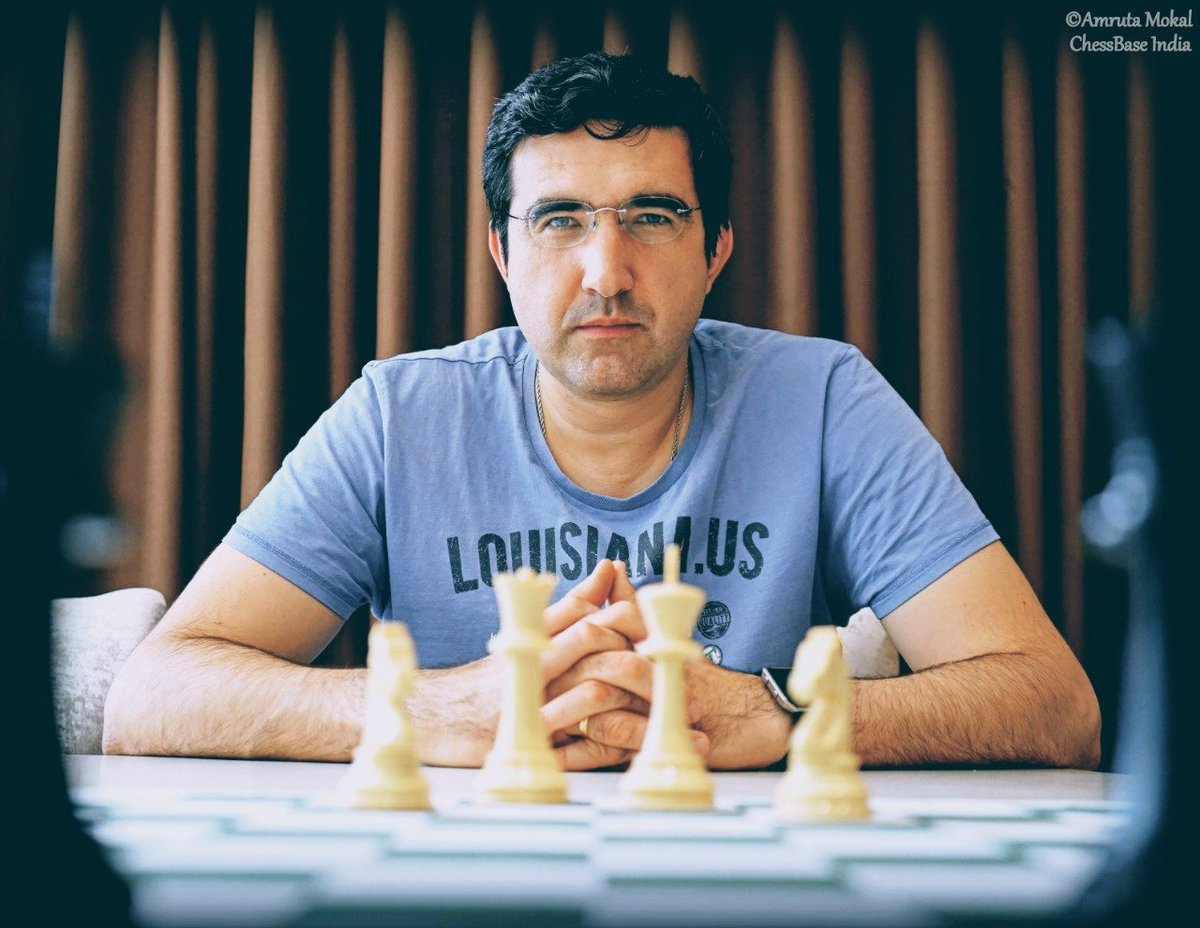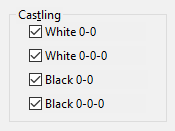


High drawing percentage has become a menace at top level chess. According to many of the experts and top players, well established theories, particularly in the opening phase of the game, is taking away much of the fun and creativity in chess. In order to combat this problem, the 14th World Champion Vladimir Kramnik has come up with a very interesting suggestion — No-Castling chess! Everything, just about every rule in it, remains the same as in the regular chess. The only change being that the players cannot castle! How does this make things different? Read the following interview where IM Sagar Shah discusses the nuances of this new variant with Kramnik himself.
Sagar Shah (SS): Hi Vladimir, great to have you on the show. You are here to talk about a new variant of chess, how do you call it? Is the the No-Castling chess?
Vladimir Kramnik (VK): Good afternoon and thank you for inviting me. I have honestly not thought about a proper name yet, it is just a proposition at the moment. It was probably proposed even before, by Bronstein, I don't know for sure. I mean, I don't claim any copyright on this idea nor do I have any financial interest in it. It is just a concept that I have been fond of for quite some time and since now I have stopped playing chess and we have a certain collaboration with DeepMind, it somehow felt right to explore it more deeply. The whole idea was quite experimental in the beginning but I feel we have done some good work and found some interesting results that ought to be presented to the general public.

SS: Okay, so coming to the core of it, what you are proposing is that let the game of chess remain absolutely the same but you just remove the rule of castling, correct?
VK: Yes. Let me start from the beginning. First of all I have been a professional chess player myself and I have felt this problem more and more at top level play. I would hear this from everybody, they would often complain especially when playing White that they have nothing to play! (laughs) Well, you are supposed to try something at least and create some chances but you have no idea how you are going to do it. We are not talking about advantage anymore, it is just about getting some chances and a reasonable fight. I have faced this problem quite a lot myself. If you see the games I played in the later years, you would notice that I was trying all kinds of things, from 1.Nf3, 1.g3 to 1.d4 2.e3, and whatever, just to find a game.
Actually I had already stopped looking for an advantage. I just wanted to get a game and even this was becoming more and more difficult. There is a clear demand from the chess fans in general who are disappointed by the statistics that reflect a huge number of draws but for me, the problem is not with the draws but the content of the games. I would like to clarify here that I am only talking about top level chess. For amateurs and club players this is not a problem at all. So I am not saying it has to be implemented everywhere. I mean, it is just a choice, to play with or without castling, and it doesn't have to necessarily substitute regular chess. But I was thinking more about getting back the interest in top level chess that has declined over time, because you know, the top level is sort of the face of chess. Again, there is clearly a demand for this as you can see Fischer random chess becoming more and more popular but Fischer random has its own problems. In my personal opinion I think No-Castling chess is a simpler and more efficient solution.

Chess variants are becoming more popular. This is evident from the fact that the first FIDE World Fischer Random Chess Championship was held this year in Norway. It was won by Wesley So (right) ahead of World Champion Magnus Carlsen | Photo: Lennart Ootes
SS: I have one question on this front. You stopped playing chess somewhere in January. Did you start thinking about all these after you stopped playing or has it been in your mind before that?
VK: Long before. Actually, I started to think about it back in 2001 already. I remember mentioning it to some players including Peter Svidler. I don't know if they remember it but it was already starting to get unpleasant back then, the amount of problems one faced to get a game was of course nothing compared to what it is now but still it was substantial. My first idea was to introduce a pairing of openings but this obviously won't work anymore because at the top level everyone seems to know everything!
The idea of tweaking the rules a bit occurred to me a few years back but firstly since I was still into competitive chess I simply didn't get the time to work on it, and secondly I needed an opportunity to check the idea carefully with certain force. I am lucky in this regard that I had the opportunity to work with DeepMind and Alpha-Zero. I wanted to be serious about what I am proposing. I wanted to check it carefully, see the games, patterns, and statistics and only then bring it to the public. I have been working with other possible variants as well and they might even be more entertaining in some ways but No-Castling is by far the simplest.
You see, if we pretend for a moment that we are learning the game of chess for the first time in life, then it is only the rule of castling that doesn't seem to make any sense. It is the only move in the entire game that involves two pieces and for no definite reasons. It is possible to make sense of en passant even because it sort of makes the game more dynamic, without the en passant rule it would be quite easy to force closed pawn structures, but castling is a very absurd move and it doesn't add to the game at all, it doesn't make it better and only makes it different. The rule of castling didn't exist originally and historically came into being much later during the 15th century or so. There are only two explanation that I can think of behind its invention. One explanation is that many centuries ago people were not that strong at chess and castling was probably a way to prolong the game, to slow it down because otherwise a game could be over in just 15 moves with a direct attack.
My second theory is funnier and more political, you know chess was for many centuries considered more as a war than a game and so in a way it was one of the means to teach people how to make war and perhaps castling was invented to explain everyone that in a war first of all you have to take care of the king. The king's safety is always the first priority even if that means he can actually escape the battlefield in a strange and unjust sort of way. This is a strange story but it might have some truth behind it. Of course, somebody invented casting and somebody implemented it, so there has to be a reason behind it. So in a way this No-Castling chess makes the rules of chess more logical. It is not only simpler but also more logical to not have the right to castle.
SS: After you started working with DeepMind, at what point did you think that No-Castling chess was good to go out to the public?
VK: I was convinced even before checking it with this monster AlphaZero that No-Castling would only make the game more dynamic. First of all, every opening theory goes out of the window in this variant of chess right from move one. It is hard to say which is the best move to start with 1.e4, 1.d4, or 1.c4. In fact, I think 1.f4 makes a lot of sense under this new circumstances as it allows you to go for the quick ♘f3-g3-♗g2-♖f1-♔f2-♔g1 (laughs). I don't know 1.f4 might as well be the best move here but the point is it completely destroys all theory!
The main criticism I have received of this variant is that it is too simple and the new theory would develop very quickly. Now I can guarantee you that this won't happen so easily, this isn't the case. For example, suppose after 1.d4 d5 2.♘f3 ♞f6 I play the move 3.h3, I am sure that both sides will play a new game after this but the point is it doesn't surprise your opponent or create a new pattern. You can try some unusual move like this in virtually every opening to have a game but you in fact don't have a game because you don't create any new patterns. After 3.h3 anyone will be able to continue logically with 3...c5 followed by Nc6.
The problem is not the concrete moves but the patterns which are very well-known but once you change the rules and disallow castling all of these changes, I mean all these pawn structures start to take a whole new meaning. I have seen the games and I can tell you nothing is the same. It is easy to find concrete lines using an engine but it isn't easy to establish general standards and I would say it would take a good thirty or forty years for that to happen. In this scenario you can certainly have equal positions but it is a different kind of equality, it is nonstandard.
But let's say if you get an even position out of a Queen's Gambit with symmetrical pawn structure then most likely the game will end in a draw. But here with the kings in the center it is totally a new situation, you have to create your own plans from scratch. Also no castling makes the game objectively more complex, it keeps a lot of options open and you have to decide whether you want to take your king to the kingside or queenside or you just want to leave it in the middle. Moreover, you have to also figure out a plan to connect your rooks. No-castling chess is closest to regular chess in a way and at the same time it concretely eliminates all theory and not just for two or three years I assure you, but for tens of years. More importantly, it is very easy to play, you might as well go inside a normal tournament and make a gentlemanly agreement with your opponent that you don't want to castle.
SS: These are very deep insights coming from you. You have obviously understood and analysed this variant of chess very deeply and we are excited to see it in action. So maybe we can look into a game and understand how it works in practice?
Kramnik goes on to show a very interesting game in No-Castling chess of Alpha-zero against itself and draws attention to some specific moments where he thinks the variant is markedly different from the regular version. Check out the full game below with detailed analyses of some amazing lines shown by the seminal AI:

[Event "Computer Selfplay"] [Site "London, UK"] [Date "2019.09.25"] [Round "?"] [White "AlphaZero-NoCastle"] [Black "AlphaZero-NoCastle"] [Result "1/2-1/2"] [ECO "D21"] [Annotator "Vladimir Kramnik"] [PlyCount "126"] [EventDate "2019.??.??"] 1. d4 d5 2. c4 dxc4 {[#]The Artificial Intelligence was given this position to start with (a Queen's Gambit Accepted). The idea was to experiment with all kinds of openings and get as broad a picture as possible.} 3. e3 e6 4. Bxc4 c5 5. Nf3 a6 {so far this looks familiar...} 6. h4 {A natural move. Even if I find Ke2 followed by Re1 and Kf1 even more logical.} h5 {stopping potential h5, Rh4} 7. a4 Nc6 8. b3 {A sensible setup under the circumstances.} cxd4 9. exd4 Bb4+ {Forgetting for a moment that White would not castle anyway? Even if so, seems like a good square for the bishop fortunately.} 10. Kf1 {[#]This is the point where the game starts to take a sharp turn. As castling isn't allowed White chooses to secure its king on g1 and develop the h1 rook to h3!} Nge7 11. Bb2 f6 12. Nbd2 Bd7 13. Kg1 Rc8 {We can only dream normally about getting such a complicated position in QGA!} 14. Ne4 {It may appear that White has a strong initiative but in fact the position is more or less balanced, and, considering the level of the players, will stay so until the end. But no doubt seeing how the game develops, if it was to be played by human grandmasters, it would likely not have been the case and a draw would certainly not be a likely outcome.} Na5 15. Be2 Bc6 16. Nfd2 {Hitting the h5 pawn, but black has a good control in the center and more active pieces in return for the eventual pawn deficit.} Bd5 {[#]} 17. Rh3 {White could have gone 17.Bxh5+ right away but that leads to some really unclear positions as Black gets a semi-open h-file at the same time highly active pieces.} (17. Bxh5+ {leads to a very unclear position after} Kf8 (17... Kd7 {might be interesting as well, running to b8} 18. Rh3 Kc7 19. Be2 Kb8) 18. Rh3) 17... Kf7 18. Bxh5+ g6 19. Bf3 Nf5 20. h5 { [#]} gxh5 $1 {The beginning of inhuman complications: Black decided to open up the position. A safer alternative obviously would have been g5. The tension is high, as often in this chess variation both kings do not feel completely comfortable, and it gets wild quickly} (20... g5 {is a bit safer, if this word can be used in this variation of chess, but after} 21. Be2 {White would have an advantage}) 21. Nb1 {Quite a move, isn't it? White decides to fight for the initiative by all means, trying to hit Black's bishop on d5.} (21. Bxh5+ Ke7 { would lead to a very complicated but rather balanced position, for example} 22. Bc3 Nc6) 21... h4 (21... Nxb3 {would lead to some amazing complications, but wouldn't objectively break the balance. Let us try to follow the thoughts of the players} 22. Bxh5+ Ke7 23. Rxb3 Bxe4 24. Rxb4 Bxg2 $1 {an unpleasant surprise} 25. Ba3 {looks decisive, but} (25. d5 $5 Qg8 (25... Bxd5 {leads to a complete mess} 26. Ba3 Kd7 27. Bf3 Qg8+ 28. Kf1 Rh3 {with equal chances (without any immediate perpetual check, just a dynamic balance)}) 26. Rxb7+ ( 26. Rg4 Rxh5 27. Ba3+ Kd7 {transposes to the main variation}) 26... Kd6 27. Ba3+ $8 Ke5 {finally finding a safe place} 28. f4+ ({or the immediate} 28. Bb2+ Kd6 29. Ba3+ Ke5) 28... Kxf4 29. Bc1+ (29. Qd2+ $2 Ne3 $19 30. Bd6+ e5 31. Bxe5+ Kxe5 32. Re7+ Kf5) 29... Rxc1 (29... Ke5 30. Bb2+ Kf4) 30. Qxc1+ Ne3 31. Qc7+ e5 32. Qg7 Bxd5 33. Nc3 {leading to an eventual draw in all variations. Don't ask why, you'll have to trust me on this.}) (25. Kxg2 $2 {loses} Qd5+ 26. Kf1 Qh1+ 27. Ke2 Qxh5+ 28. Ke1 Qh1+ 29. Kd2 Qh2 30. Qf3 Rh3 31. Qxb7+ Rc7) 25... Qg8 $3 {is a shocking counterblow} 26. d5 $1 {the only way to stay in the game for white and it might actually hold, for example} Rxh5 (26... Be4+ 27. Kf1 Qg2+ 28. Ke1 {holds}) 27. Rg4+ $8 Kd7 $8 28. dxe6+ $8 (28. Kxg2 { what is wrong with this, you might ask?} Ne3+ $1 29. fxe3 Rc2+ $1 30. Kg3 Rh3+ $1 31. Kxh3 Qh7+ 32. Rh4 Qf5+ 33. Rg4 Qh5+ 34. Kg3 Qh2+ 35. Kf3 Qf2+ 36. Ke4 Qf5+ 37. Kd4 Qxd5#) 28... Kc7 $8 29. Kxg2 (29. Rxg8 Rxg8 30. Qxh5 Bf3+ 31. Kf1 Bxh5 32. Nd2 {is enough to save it as well}) 29... Qxe6 30. Bc1 $1 Kb8 (30... Kb6 $5 31. Bf4 Rg8 32. Nc3 Rxg4+ 33. Qxg4 Nh4+ 34. Kg3 Nf5+ 35. Kg2 Nh4+ { is a draw}) 31. Bf4+ Ka8 32. Ra3 $1 {holding a draw after any of Black's numerous attempts.}) 22. Bh5+ Ke7 23. Nbc3 Bxb3 {The black position looks dangerous, but don't worry, it's all under control.} 24. Qg4 (24. Qf3 {was a serious alternative, leading to an approximately equal position after} Bd5 $13) 24... Qg8 {[#]} 25. d5 $1 {Although the queens are about to be exchanged it doesn't really calm down the position as the black king is clearly under fire! The evaluation of this position is extremely unclear at least from a human standpoint.} Qxg4 26. Bxg4 {I have noticed that even exchanging queens often does not lead to the position "calming down" due to a chronic king's vulnerability} Rhg8 27. Bxf5 exf5 28. Nxf6 {[#]The show is far from over even after the queens are off the board.} Rg6 29. Nh5 Kf7 {The endgame is equal but that usual equal as we know it...} 30. Nd1 $1 {Very resourceful. The fight for the initiative never ends with the "centralized" kings. The idea is rerouting the knight to e3 and once again fighting for the advantage.} Bd2 $1 (30... Bxd1 31. Rxd1 {would leave a minor plus for White.}) 31. Ne3 Bxe3 32. Rxe3 Bxd5 $1 { Well calculated!} 33. Nf4 Nc4 $1 34. Nxg6 (34. Nxd5 {is drawish as well} Nxe3 35. Nxe3 f4 36. Nf5 Rc2) 34... Nxe3 35. Ne5+ Ke8 36. fxe3 {[#]} Rc2 $1 { The point of Black's combination, trivial stuff for the computer, not so for human players. AlphaZero plays the only move at the end of a long sequence that keeps the balance. Now the g2 pawn falls and Black gets sufficient counterplay with its extra pawns.} 37. Ba3 Rxg2+ 38. Kf1 Rh2 (38... h3 39. Rc1 Be6 40. Rc7 Ra2 41. Re7+ Kd8 42. Rxe6 Rxa3 43. Nf3 f4 {draws}) 39. Rc1 Rh1+ 40. Kf2 Rh2+ 41. Ke1 Rh1+ 42. Kf2 Rh2+ 43. Kf1 Rh1+ 44. Ke2 Rxc1 45. Bxc1 h3 46. Nf3 b5 {required some accurate calculation, but that never seemed to be a problem for AlphaZero...} 47. axb5 axb5 48. Nh2 (48. Kf2 Kd7 49. Kg3 Bxf3 50. Kxf3 Ke6 51. Kg3 Kd5 52. Kxh3 Ke4 53. Kg3 b4 54. Kf2 b3 55. Ke2 f4 {was an important line shown after the game by both players at the press conference with us}) 48... Kd7 49. Kd3 Kc6 50. Ba3 Kb6 51. Kd4 Be4 52. Bb4 Bg2 53. Be1 Ba8 54. Bc3 Be4 55. Bd2 Bb7 56. Bc3 Be4 57. Bd2 Bg2 58. Ke5 Kc5 59. Kxf5 Kc4 60. Kf4 b4 61. e4 Bxe4 62. Kxe4 b3 63. Bc1 Kc3 1/2-1/2
Still unsure about this "no-castle" chess after watching this game? Try this at home!
SS: So you think organizers should already go ahead get some players and try out this new format of the game?
VK: Of course, they can if they want to, I don't insist. But you know, I have actually met many organizers who were worried about the increasing number of draws in the game of chess so of course, they can go ahead and try it out, why not! Also I don't think there should be any issue in rating games of chess played in this new format because it is exactly the same chess except that you play here from move 1 instead of move 20! But more importantly I would like people to try it out at home, in friendly blitz games, so that we get more feedback about it. I would really appreciate it if people gave their feedback to me, not only in general but after actually playing some games in it. I believe this version is by no means less than Fischer random or for that matter even standard chess.
SS: Well, thank you Vladimir for presenting this to us. A final question to you, if suppose such a tournament were to be held where No-Castling was introduced. Would you be interested in playing it, now that you have retired from competitive chess?
VK: For this particular case, I have to say I will make an exception. Normally I am not planning to play in any classical event, not even in rapid. But for No-Castling chess, yes I will consider. I really hope that there will some open tournaments or may be in a normal tournament some players will decide to play against the rules. It can be done and it would still be rated. Everybody is welcome to try it and then we will see.
SS: Thank you so much Vladimir for speaking to us. We really hope that this variant of chess will catch up and a lot of people will try it out!

Do you think No-Castling can be a viable alternative to regular chess, just like Fischer random? Share your thoughts in the feedback section below, but best of all after you have played some games. You can also try some computer vs computer matches yourself – simply enter some opening you wish to explore but include a king move which you then take back, e.g. in the above game after 1.d4 d5 2.c4 dxc4 enter 3.♔d2 ♚d7 4.♔e1 ♚e8. After that the computer will play No-Castling Chess.
 Another method: in ChessBase or Fritz start a game not with Ctrl-N (= new game) but with "S" (= setup position), click "Reset" (to get the initial position) and then unclick the four possible castling rights.
Another method: in ChessBase or Fritz start a game not with Ctrl-N (= new game) but with "S" (= setup position), click "Reset" (to get the initial position) and then unclick the four possible castling rights.
After that you are set to go. Please send results and games to me at ChessBase India. We would be interested to discuss them with Vladimir Kramnik.